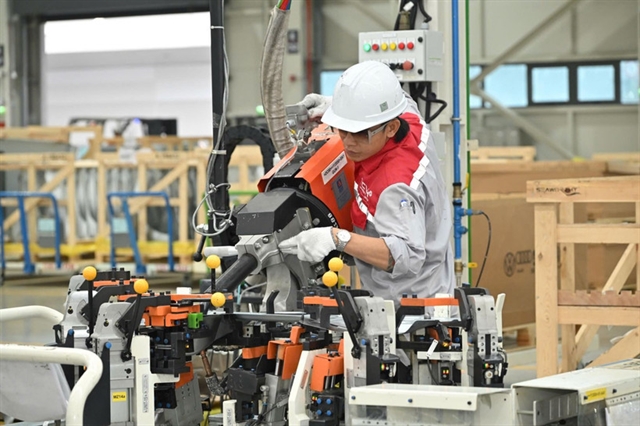 Society
Society

 |
| Song Lake in Đại Mỗ Ward of Hà Nội's Nam Từ Liêm District is illegally encroached by waste dumping and construction works. — Photo kinhtedothi.vn |
HÀ NỘI — Many ponds and lakes in Hà Nội, currently, are being illegally filled and encroached.
This is really not a new story, but it remains a difficult problem for local authorities.
In addition to being illegally filled and encroached, the lack of water flow in many lakes causes the lake bed to dry out and become covered with vegetation, creating conditions for illegal encroachment and filling of lakes.
Hà Nội has about 122 lakes, and 13 rivers flowing through it.
In the 2015-20 period, the urban natural water surface area decreased by more than 203ha because more than 60 per cent of ponds and lakes were filled and levelled.
It is time to put in place strong and fundamental solutions to protect lakes and ponds, to protect the city's green lungs.
Ponds and lakes are not only the green lungs of the city, but also a place to store and drain excess water during the rainy season.
Without a timely solution, at some point, Hà Nội will not only lose these green lungs but also suffer from flooding and poor drainage every rainy season.
A typical example is Song Lake, located in Đại Mỗ Ward of Nam Từ Liêm District.
This is a large lake with clear blue water creating a fresh space for neighbouring residential areas.
However, over the past 5-6 years, the encroachment of the lake has become more and more serious.
The issue got out of control recently when the lake dried up and its bed became bare and overgrown with wild grass.
Taking advantage of this, people have continuously dumped waste into the lake to fill the space and illegally build workshops and other structures.
Vice Chairman of Đại Mỗ Ward Nguyễn Viết Hùng told Kinh tế & Đô thị (Economic and Urban Affairs) newspaper that the practice of dumping waste to fill Song Lake has happened for many years.
In particular, since there was an asphalt road connecting Thăng Long Avenue to the Vinhomes Green Villas residential area, illegal dumping of waste into the lake has become more complicated because the road to the lake is more convenient, said Hùng.
In order to address the situation, the local authority has taken many measures such as digging separation trenches and building barricades, to separate the edge of the lake from road, Hùng said.
However, due to the authority’s limited staff and the large area involved, the inspection and handling of illegal waste dumping still face many difficulties, he said.
Similarly, Đỗi Lake in Định Công Ward of Hoàng Mai District is also being destroyed by dumped waste.
Frustrated by the situation, residents living nearby contributed their own money to build a security gate to prevent people from illegally dumping waste into the lake.
Another example is Láng Pond located in Tây Hồ District.
Although it has not been seriously threatened by waste dumping like Song and Đỗi lakes, for many years this pond has had lower water levels and it continues shrinking.
Phạm Văn Cường, a resident in the district’s Quảng An Ward said: “For a long time, Láng Pond was practically abandoned, and some people used it as a place to plant trees.”
“Witnessing this, we who once enjoyed the fresh air that Láng Pond had brought could not help but feel sad,” Cường said.
The biggest concern of people in this area is that there is no longer any water source, so the possibility of reviving this pond is very small.
Even more worrying, once the pond cannot be revived and is turned into a high-rise building, ecological and climate change dangers will become even more severe.
To deal with the encroachment of ponds and lakes, many localities have built embankments around ponds and lakes.
However, a new problem soon arose, causing more pollution.
Waste sewers from people's houses, restaurants, eateries and workshops discharge directly to ponds and lakes, making these places no different from giant waste tanks and always emitting an unpleasant odour.
Mass fish deaths in many large ponds and lakes have occurred regularly for many years, without no solution.
From a legal perspective, lawyer Bùi Đình Ứng from the Hà Nội Bar Association said that to protect Hà Nội’s lakes and ponds, it is necessary to assign specific responsibilities to localities where those lakes and ponds are located.
"Local governments must be the unit to manage and protect lakes and ponds and bear the main responsibility when lakes and ponds in the area are illegally encroached or filled," said Ứng.
“In addition, acts of encroachment and destruction of ponds and lakes must be imposed strict sanctions,” the lawyer said.
Associate Professor Dr Trương Mạnh Tiến, member of the Việt Nam Union of Science and Technology Associations, said that to effectively protect lakes and ponds from pollution and illegal encroachment, first of all, it is necessary for ponds and lakes to have owners so that someone can take responsibility whenever a problem or incident happens to that pond or lake.
According to this expert, solving the problem of pond and lake pollution requires resources, technology and especially the participation of the whole community.
“The community here means a community of residents who supervise, community of scientists who help with technology issues, and community of businesses who fund the maintenance and protection of ponds and lakes," Tiến said.
Early last year, the Hà Nội People's Committee issued a list of 3,164 lakes and ponds that cannot be filled to tighten management and make it public for people to implement and avoid unclear regulations in handling violations.
But in fact, in recent years, the effectiveness of pond and lake protection has not been improved; many ponds and lakes are still polluted and continue to be encroached without a plan to resolve the issue.
It is time to pay more attention, protect lakes and ponds from pollution, renovate them, creating a civilised appearance for the capital city.
Lakes and ponds are extremely valuable for urban people, said Phạm Ngọc Đăng, vice president of the Việt Nam Natural and Environment Protection Association. VNS




